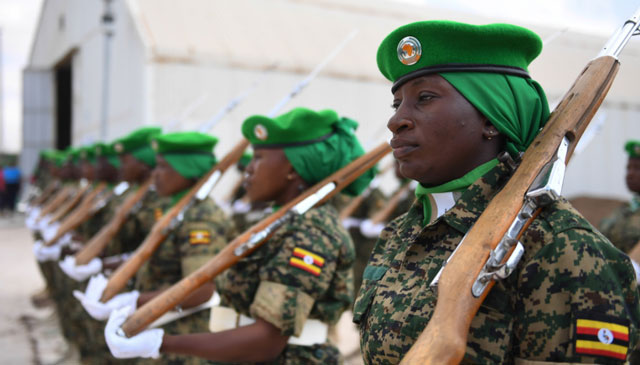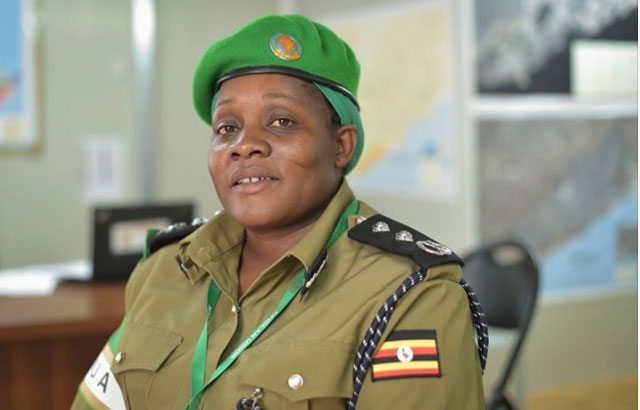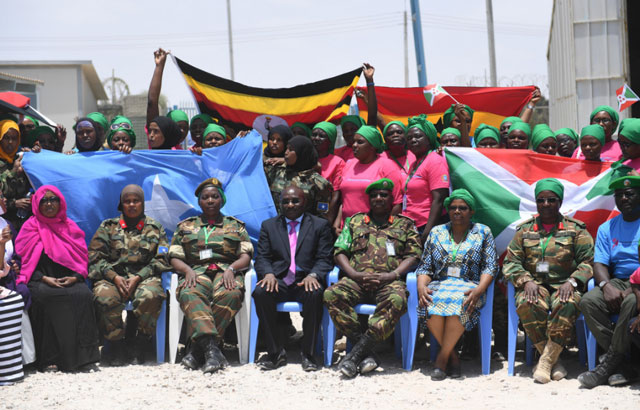
THE WOMEN OF AMISOM: Pressing for Progress Towards 50/50
Mogadishu | AMISOM | Under a clear sunny March 8, 2018 morning in Mogadishu, Somalia, two hundred women have gathered within the AMISOM basecamp, situated in the vicinity of the Horn of Africa country’s International Airport. Even if they are adorned in regular matching white, pink and blue t-shirts with uniform branding on their backs, it is hard to misunderstand what they are and who they represent.
Neat in their sturdy boots, camouflage trousers and with vibrancy in each one of them, the women are a fraction of the eight hundred and fifty (850) female peacekeepers who currently make up part of the 22,130-strong force of the African Union Mission in Somalia, AMISOM, combating the militant group Al-Shabaab and other armed actors to enforce peace and restore stability.
They have gathered in the capital city today to take stock of their contribution to global peace, to mark International Women’s Day. Importantly, they are congregating to chart new ways to bolster this contribution for the sake of the ordinary woman, understanding vividly that their struggle for peace is critical for the rights of women and girls, not just in Somalia, but in Africa and the world.
“Women’s Day has a special significance to women in peacekeeping. The United Nations Security Council Resolution 1325 on women and peace and security also was launched 18 years ago today,” Stella Maranga, a Gender Officer with the AU Mission notes. “It is a very exciting day for the women of AMISOM,” she adds.
Maranga calls for 50/50
According to Maranga, International Women’s Day is a celebration, of women in this part of sub-Saharan Africa and around the world. Equally prominently, it is a call to action for global policy and decision-makers to put into action and practice the foundations of gender equality and equity, so the world can achieve 50/50 representation and participation of both men and women by 2030.
As part of their activities for this year’s celebration, and the reason for their assembly under the scorching tropical sun this morning, the two hundred women, representing their various contingents, will march through the expansive AMISOM basecamp to demonstrate their solidarity with women all over the world, especially Somali women who have borne the brunt of insecurity in the Horn of Africa where they serve.
“We are spread out across headquarters and rural Forward Operating Bases in our Areas of Responsibility, attending to our various Mission posts daily. Today is special because it’s a day we get the chance to come together in large numbers, know one another and advocate for a common cause dear to all of us as women in peacekeeping,” Lt. Col Glenna Josephine Nicholson, an officer from Sierra Leone says.
Once they arrive at the imposing prefabricated JMTC conference hall on the other end of the camp, they will have reached their destination. Here, they will settle down to a four-hour conference where they will be joined by their Somali counterparts. Together the women will exchange views and insights amongst themselves and with the Mission leadership, for the purpose of advocating for more women to serve not just in Somalia and specifically the AU Mission, but in peacekeeping across the globe.
An International Peace Institute study of 182 peace agreements signed between 1989 and 2011 found that when women are included in peace processes, there is a 35 percent increase in the probability that a peace agreement will last fifteen years or more. But what is it exactly that the AMISOM women stand on to boldly call the world to attention to hear their plea of advocacy?
“There is a common misconception that when women call for action on issues such as 50/50 participation and representation, we want half the roles simply portioned off and handed to us for the plain biological fact of our gender. No, this is not the case,” Chief Inspector of Police Mavis Kabila, a lively police officer from Zambia, chipping in in the spirited mid-morning discussion submits. “We make the call because we know well that we can back it up with practical facts and evidence-based arguments detailing our vast contribution.”

Alalo: We do not believe in being handed things
Christine Alalo, AMISOM’s Deputy Police Commissioner, now acting Head of the African Union Police in Somalia and the Mission’s top woman in leadership agrees. “We do not believe in being handed things. We call for more women in peacekeeping because we have seen what contribution they make. We recognize, our leadership recognizes, the continent and the world recognize, the difference we have made in the cause for peace in Somalia. We have put in the work and we see how much we have changed.”
Commissioner Alalo adds that had they been of even a bigger number than they are currently, this impact would be multiplied several times over.
The African Union Mission in Somalia is a clear example of the impact that women are capable of in peacekeeping and a model for women in peacekeeping for global policymakers. The largest and deadliest peacekeeping mission in the world, one would especially think its leadership would shy away from the involvement of women in such difficult and dangerous work as active combat, commonly believed to be better suited for men and restricted in many of the world’s armies.
“AMISOM female peacekeepers are an inspiration to many women and men, especially in the host communities across Somalia,” the Head of the AU Mission in Somalia, Ambassador Francisco Madeira Caetano says. “They are members of specialized units, doing critical work to ensure the Mission’s effectiveness. They are out in the towns building the capacity of their Somali counterparts in the security sector and they stand with the local Somali woman every day.”

Lt Gen Oweyesigire could not be prouder of his troops
For Lt. General Jim Beesigye Owoyesigire, the Mission’s Force Commander, he could not be prouder of the women who serve under his command.
“The women of AMISOM are commanders in their units, they are out in the trenches fighting Al-Shabaab, manning heavy artillery including tanks and massive guns on the frontline,” he says. “They are in Information and Communication Technology sectors, providing critical IT support and gathering intelligence to enable operations and keep entire battlegroups alive and safe. In the offices, they are in administration and in leadership and work with their male colleagues to ensure that battalions stay organized, accountable and alive.”
Given the undeniable contribution of female soldiers in conflict resolution and peace enforcement, one wonders why there aren’t more of them in peacekeeping. Of the forces serving in the many Missions across the world, less than 5 percent are women. According to Stella Maranga, the issue of the number of women in these operations starts first and foremost with the number of women in the militaries that contribute the peacekeeping troops themselves.
“To address the issues of the small numbers of women deployed in Missions, we must address the factors that are preventing more women from enlisting into the army. Widespread beliefs such as women are not physically strong enough or emotionally tough enough to be fit for military work are some of the questions we must factually address,” she says.
Inside the world’s missions such as AMISOM, however, the absence of appropriate and adequate facilities necessary for female soldiers to maintain proper health in physically and mentally less than ideal conditions is a deterrent to the willingness of countries to deploy their female troops, Ms. Maranga adds. Increasing funding to peacekeeping would be one of the ways to solve this problem.
Having, for years, called for increased, predictable and sustainable funding for its operations with little and slow response from the international donor community, AMISOM continues to grapple with delivering an ambitious mandate within limited resources. The Mission also took cuts on troop allowances two years ago, of up to 20 percent, when its biggest donor, the European Union cut its funding over competing priorities.
There is need to do more from the country level all the way into the missions, starting with encouraging and supporting girls into the military, and female peacekeepers such as the women of AMISOM have a big role to play in this endeavor, being frontline role models for the world. Whether global leaders will heed their call and tackle the issues hindering the participation of more women in peacekeeping is another story. But one thing is for sure: the women of AMISOM are a sterling example of the benefits the world stands to reap from a 50\50 reality.
***
SOURCE: AMISOM
 The Independent Uganda: You get the Truth we Pay the Price
The Independent Uganda: You get the Truth we Pay the Price





